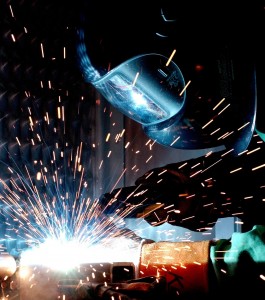
 Become a PowerPoint Guru by Dave Tracy
Become a PowerPoint Guru by Dave Tracy
Learn the methodologies, frameworks, and tricks used by Management Consultants to create executive presentations in the business world.

 Become a PowerPoint Guru by Dave Tracy
Become a PowerPoint Guru by Dave Tracy
 Artificial Intelligence (AI) is one area considered by many executives to enable Automation and steer positive growth. A couple of years ago, most executives thought that deployment of Artificial Intelligence isn’t a big deal. However, revamping traditional systems, implementing AI, and scaling it, in reality, is not as simple as it seems.
Artificial Intelligence (AI) is one area considered by many executives to enable Automation and steer positive growth. A couple of years ago, most executives thought that deployment of Artificial Intelligence isn’t a big deal. However, revamping traditional systems, implementing AI, and scaling it, in reality, is not as simple as it seems.
A survey by PwC Research in 2020, which gathered responses of 1062 business leaders, validates that scaling and industrializing AI is not straightforward at all. Only 4% of the respondents asserted that they plan on implementing organization-wide AI in 2020. A year earlier, the same survey revealed 20% of the executives planning to do that. The survey shows a significant decrease in the number of senior leaders thinking of executing AI.
The reason for this dwindling interest in AI deployment is mainly because of the tough prerequisites necessary—contemplation, resources, preparedness, overhauling legacy systems, and integration of technology applications—for enterprise-wide AI implementation.
A robust AI Implementation Strategy needs to be first devised in order to assist the organizations in moving forward with their AI deployment plans. Research reveals 5 key priorities of AI Strategy that businesses should follow to position themselves as AI leaders and reap value from Transformation in future. These priorities not only highlight the key requirements for AI deployment but also pinpoint ways to maximize pay offs associated with the initiative:
Let’s delve deeper into a few of these key priorities.
One of the key reasons to employ AI, as cited by PwC research, is to automate routine administrative functions—e.g., using AI to pull information from tax forms, bills of lading, or invoices that can otherwise take up long hours of human effort. 44% of respondents revealed that AI will help them operate more efficiently.
To ensure AI adds value to the business, leaders should develop a strategy to identify the areas where AI can have a much deeper impact; build capabilities to do that; develop AI solutions, govern them, and embed them with existing systems.
Building or enhancing the capabilities of the workforce to become AI ready is critical today not only for technology enterprises but also for other businesses. Organizations should identify the skills required for AI and train their people to deploy AI solutions.
However, thinking of achieving this through traditional means of offering training sessions isn’t a viable strategy to tap the opportunities offered by AI. In addition to training people, organizations should cross-skill their people in multiple trades and provide them the opportunities to apply and hone in the skills learnt. In fact, organizations should reward people who apply what they learn into real-time problem-solving and productivity enhancement.
AI can be perilous if adequate understanding of its responsible use and necessary procedures to protect against its risks and negative usage are not taken. There are growing apprehensions around AI related risks e.g., biased algorithms, facial recognition tools, and deep fakes. As per PwC survey, a large majority of respondents, using AI routinely, declared readiness in their organizations in terms of taking sufficient measures to protect against AI risks.
However, in reality most organizations are quite far from implementing controls around data and decisions generated using AI. Just about 33% businesses mentioned having the ability to fully tackle risks associated with data powering AI, AI models, outputs, and reporting. It is imperative to have rigorous Risk Management processes in place to effectively use AI in the workplace and address the risks associated with it. AI risks can be mitigated by integrating processes, tools, and controls needed to address AI bias, explainability, security, accountability, and ethics.
Interested in learning more about the other key strategic priorities essential for AI deployment readiness? You can download an editable PowerPoint on Artificial Intelligence Strategy: Top Priorities here on the Flevy documents marketplace.
You can download in-depth presentations on this and hundreds of similar business frameworks from the FlevyPro Library. FlevyPro is trusted and utilized by 1000s of management consultants and corporate executives. Here’s what some have to say:
“My FlevyPro subscription provides me with the most popular frameworks and decks in demand in today’s market. They not only augment my existing consulting and coaching offerings and delivery, but also keep me abreast of the latest trends, inspire new products and service offerings for my practice, and educate me in a fraction of the time and money of other solutions. I strongly recommend FlevyPro to any consultant serious about success.”
– Bill Branson, Founder at Strategic Business Architects
“As a niche strategic consulting firm, Flevy and FlevyPro frameworks and documents are an on-going reference to help us structure our findings and recommendations to our clients as well as improve their clarity, strength, and visual power. For us, it is an invaluable resource to increase our impact and value.”
– David Coloma, Consulting Area Manager at Cynertia Consulting
“FlevyPro has been a brilliant resource for me, as an independent growth consultant, to access a vast knowledge bank of presentations to support my work with clients. In terms of RoI, the value I received from the very first presentation I downloaded paid for my subscription many times over! The quality of the decks available allows me to punch way above my weight – it’s like having the resources of a Big 4 consultancy at your fingertips at a microscopic fraction of the overhead.”
– Roderick Cameron, Founding Partner at SGFE Ltd
 Technological advancement has come a long way. Artificial Intelligence is taking charge of a number of repetitive logistics tasks. Organizations are benefiting from Automation in streamlining their cumbersome processes and cutting down delivery times.
Technological advancement has come a long way. Artificial Intelligence is taking charge of a number of repetitive logistics tasks. Organizations are benefiting from Automation in streamlining their cumbersome processes and cutting down delivery times.
Automation is profoundly affecting the way Logistics are handled. It is disrupting the entire Logistics Supply Chain, not just the warehousing, picking, and sorting functions. The impact of Automation on roads, rails, and ports is immense. Ports are increasingly embracing Automation, but they haven’t yet started getting the return on their investments.
In Logistics, ocean and air shipment has potential for Automation—which is certainly under way—but its effect on enhancing throughput is yet to be seen. Logistics operations are being transformed at quite a pace with new models, concepts, and offerings evolving rapidly. With the current pace of technology evolution, experts believe Logistics operations would be done autonomously in the not too-distant future.
The COVID-19 pandemic has disrupted businesses and industries alike significantly. Businesses are trying to grapple with the ambiguities the situation has presented to them. Automation is being viewed by many Logistics companies to be the only option to prepare for and survive in the future.
Logistics companies are exploring ways to automate their businesses mainly due to 3 trends that are shaping their industry. These 3 trends include:
Let’s talk about these trends in a bit detail.
Labor markets are stiffening globally with lowest unemployment rates and high wages. Online retailers everywhere have a huge demand for skilled workers. This demand rise steeply in the holiday season. A sizable workforce is engaged in Supply Chain related jobs—about 4 million only in the US as packers, handlers, and supervisors in warehouses. This translates to $100 billion in payroll costs. Automation will definitely reduce this cost head. However, it will have implications for the workforce.
Another trend that is affecting the Logistics industry immensely is the explosive growth of E-commerce retailers. The sales of e-tailers are growing at a consistent pace every year. With this trend, the range of products has grown considerably, benefiting the logistics businesses. Logistic companies are making significant profit from this large volume of online shipment orders—saving about $12 to $20 on a sale of $100.
Interested in learning more about the trends that are shaping the Logistics operations? You can download an editable PowerPoint presentation on 3 Trends Driving Logistics Automation here on the Flevy documents marketplace.
You can download in-depth presentations on this and hundreds of similar business frameworks from the FlevyPro Library. FlevyPro is trusted and utilized by 1000s of management consultants and corporate executives. Here’s what some have to say:
“My FlevyPro subscription provides me with the most popular frameworks and decks in demand in today’s market. They not only augment my existing consulting and coaching offerings and delivery, but also keep me abreast of the latest trends, inspire new products and service offerings for my practice, and educate me in a fraction of the time and money of other solutions. I strongly recommend FlevyPro to any consultant serious about success.”
– Bill Branson, Founder at Strategic Business Architects
“As a niche strategic consulting firm, Flevy and FlevyPro frameworks and documents are an on-going reference to help us structure our findings and recommendations to our clients as well as improve their clarity, strength, and visual power. For us, it is an invaluable resource to increase our impact and value.”
– David Coloma, Consulting Area Manager at Cynertia Consulting
“As a small business owner, the resource material available from FlevyPro has proven to be invaluable. The ability to search for material on demand based our project events and client requirements was great for me and proved very beneficial to my clients. Importantly, being able to easily edit and tailor the material for specific purposes helped us to make presentations, knowledge sharing, and toolkit development, which formed part of the overall program collateral. While FlevyPro contains resource material that any consultancy, project or delivery firm must have, it is an essential part of a small firm or independent consultant’s toolbox.”
– Michael Duff, Managing Director at Change Strategy (UK)
 Manufacturing today entails immediate yet informed decision making. However, with increasing levels of sophistication and production, senior leadership often has limited time to make optimum decisions pertaining to the number of unanticipated issues surfacing from time to time. These issues—if not managed properly and timely—can lead to defects and wastes.
Manufacturing today entails immediate yet informed decision making. However, with increasing levels of sophistication and production, senior leadership often has limited time to make optimum decisions pertaining to the number of unanticipated issues surfacing from time to time. These issues—if not managed properly and timely—can lead to defects and wastes.
Top global enterprises are utilizing innovation and creative ways to enable prompt decision making. Specifically, they are using Internet of Things (IoT) to effectively handle critical aspects of manufacturing. Successful implementation of a Manufacturing IoT system facilitates in automating key tasks, decisions and processes; curtailing scrap and rework; and enhancing productivity.
People often object to implementing an IoT system by citing other important projects that they are already undertaking and the resource and time constraints as pressing hurdles. To work around these limitations, manufacturers can engage 3rd party consultants having proven expertise in end-to-end successful IoT, Asset Tracking, and manufacturing systems deployment.
Implementing a Manufacturing IoT System leverages immense benefits, including:
However, harnessing IoT necessitates careful deliberation and planning. The core requirements to effectively implement a Manufacturing IoT system can be segregated into 2 broad categories:
Functional Requirements (FR) describe the system or its components. FR provide a description of services that the Manufacturing IoT system must offer. FR for Manufacturing IoT may include:
All systems require availability of certain software resources, functionalities, or other hardware components. These prerequisites have to be met in the design of a system. Typical System Requirements for manufacturing IoT may include:
Let’s delve deeper into some of the Functional Requirements for now.
The system should be able to manage multiple assets and add new assets. It should be capable of:
The IoT system should be able to:
The system should maintain:
The IoT manufacturing system should record all maintenance needs and maintenance activity performed on an asset. Specifically it should:
The IoT manufacturing system should:
Interested in learning more about the details of other Functional and System Requirements of a Manufacturing IoT system? You can download an editable PowerPoint on Manufacturing: Internet of Things Implementation here on the Flevy documents marketplace.
You can download this and hundreds of other consulting frameworks and consulting training guides from the FlevyPro library.

Survival of a business in this digital age largely depends on its ability to timely embrace Digital Transformation. Digital Transformation entails using Digital Technologies to streamline business processes, culture, and customer experiences.
In order to compete today—and in future—and to enable Digital Transformation, organizations should work towards fostering a culture of continuous learning, since Digital Transformation depends on learning and innovation. The organizations that holistically embrace this culture are called “Next-Generation Learning Organizations.”
The next generation of Learning Organizations capitalize on the following key variables; Humans, Machines, Timescales, and Scope. These organizations incorporate technology in enabling dynamic learning. Creating Next-Generation Learning Organizations demands reorganizing the entire enterprise to accomplish the following key functions to win in future:
Next-Generation Learning Organizations make the best use of their time. They appreciate the objectives that can be realized in the short term and those that take long term to accomplish. Learning quickly and in the short term is what many organizations are already doing, e.g., by using Artificial Intelligence, algorithms, or dynamic pricing. Other learning variables that effect an organization gradually are also critical, e.g., changing social attitudes.
Rather than having people to design and control processes, Next-generation Learning Organizations employ intelligent machines that learn and adjust accordingly. The role of people in such organizations keeps evolving to supplement intelligent machines.
The Next-generation Learning Organizations incorporate economic activities beyond their boundaries. These organizations act like platform businesses that facilitate exchanges between consumers and producers by harnessing and creating large networks of users and resources available on demand. These ecosystems are a valuable source for enhanced learning opportunities, rapid experimentation, access to larger data pools, and a wide network of suppliers.
Next-generation Learning Organizations make learning part and parcel of every function and process in their enterprise. They adapt their vision and strategies based on the changing external environments, competition, and market; and extend learning to everything they do.
With the constantly-evolving technology landscape, organizations will require different capabilities and structures to sustain in future. A majority of the organizations today are able to operate only in steady business settings. Transforming these organizations into the Next-Generation Learning Organizations—that are able to effectively traverse the volatile economic environment, competitive landscapes, and unpredictable future—necessitates them to implement these 5 pillars of learning:
1. Digital Transformation
Traditional organizations—that are dependent on structures and human involvement in decision making—use technology to simply execute a predesigned process repeatedly or to gain incremental improvements in their existing processes. The Next-generation Learning Organizations (NLOs), in contrast, are governed by their aspiration to continuously seek knowledge by leveraging technology. NLOs implement automation and autonomous decision-making across their businesses to learn at faster timescales. They design autonomous systems by integrating multiple technologies and learning loops.
2. Human Cognition Improvement
NLOs understand AI’s edge at quickly analyzing correlations in complex data sets and are aware of the inadequacies that AI and machines have in terms of reasoning abilities. They focus on the unique strengths of human cognition and assign people roles that add value—e.g., understanding causal relationships, drawing causal inference, counterfactual thinking, and creativity. Design is the center of attention of these organizations and they utilize human imagination and creativity to generate new ideas and produce novel products.
3. Man and Machine Relationship
Next-generation Learning Organizations (NLOs) make the best use of humans and machines combined. They utilize machines to recognize patterns in complex data and deploy people to decipher causal relationships and spark innovative thinking. NLOs make humans and machines cooperate in innovative ways, and constantly revisit the deployment of resources, people, and technology on tasks based on their viability.
Interested in learning more about the other pillars of Learning? You can download an editable PowerPoint on Digital Transformation: Next-generation Learning Organization here on the Flevy documents marketplace.
You can download this and hundreds of other consulting frameworks and consulting training guides from the FlevyPro library.
Error: Twitter did not respond. Please wait a few minutes and refresh this page.